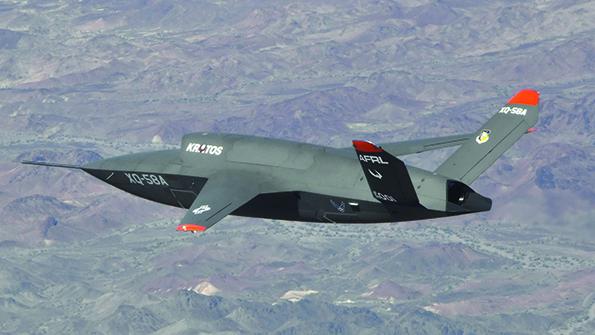U.S. Air Force Plots Fleet Insertion Path For ‘Loyal Wingman’

The format of the U.S. Air Force’s “fireside chat” series is well-understood. A technology pioneer such as Jeff Bezos, Richard Branson or Mark Cuban appears onstage at an Air Force-affiliated event, counsels an audience of pilots and airmen about innovation and, not least, tries not to offend anyone. Elon Musk arrived at the Air Warfare Symposium on Feb. 28 with a different plan.
The founder of SpaceX and Tesla, who seems to delight in publicly tweaking established competitors in the space market such as Boeing and Lockheed Martin, sat on the Air Force Association’s (AFA) stage and declared that the fighter aircraft—for decades the heart of the Air Force’s tactical combat capability—is already irrelevant.
- Unmanned aircraft eyed to replace Block 25 and 30 F-16s
- Kratos set to deliver 12 XQ-58s by early 2021
“The fighter-jet era has passed,” Musk said, provoking audible gasps and murmurs in an audience peppered with officers clad in flight suits. Lt. Gen. John Thompson, Musk’s interviewer, quickly changed the subject.
Hours later, Musk clarified in a tweeted reply to Aviation Week that he meant the fighter aircraft remains relevant, just not the pilot onboard.
“The competitor [to a manned fighter] should be a drone fighter plane that is remote-controlled by a human, but with its maneuvers augmented by autonomy,” Musk writes.
Musk’s comments on airpower should be taken with a grain of salt. Although his companies have sought to disrupt the space, automotive and mining industries, Musk has no track record in the aircraft sector. One of his symposium hosts, David Deptula, a retired lieutenant general who is now dean of the AFA’s Mitchell Institute, also pointed out in a rapidly published rebuttal in Forbes that Musk’s predictions about autonomy are often wrong, even when it concerns the self-driving capabilities of Tesla cars.

But Musk’s remarks only differed with those of senior Air Force officials at the same event in the details of timing and scope. For over a year, Will Roper, assistant secretary of the Air Force for acquisition, technology and logistics, has championed a vision of future airpower populated by numerous, small batches of autonomous aircraft augmenting manned fighters with specialized capabilities. For the first time, Gen. James Holmes, head of Air Combat Command (ACC), offered a path to introducing such aircraft into the fleet around 2025-27.
In the near term, the Air Force is focused on replacing aging F-15C/Ds with a mix of Boeing F-15EXs and Lockheed Martin F-35As. The Air Force decided to add the F-15EX to its inventory last year even as the Air Force Research Laboratory (AFRL) began experimenting with a new class of low-cost aircraft with an “attritable” value.
The first such experimental aircraft, the Kratos XQ-58A Valkyrie, in March 2019 completed the first of four flights made to date. Next year, the Air Force plans to fly the XQ-58A or a similar aircraft with an artificial intelligence “brain,” which allows the so-called Skyborg aircraft to learn maneuvers as it flies. Such capabilities are not far from Musk’s vision of future air combat, but they are too immature to replace a fleet of F-15Cs on the verge of being grounded; hence, the decision to buy the F-15EX instead.
The next opportunity to introduce a new kind of aircraft comes in about 5-8 years, Holmes says. That timing dovetails, perhaps intentionally, with the schedule for maturing aircraft such as the XQ-58A and Skyborg. The Air Force will need to replace hundreds of F-16 Block 25s and Block 30s, which entered production in the mid-1980s.
“There’s an opportunity there if we want to cut in something new, a low-cost attritable, loyal wingman and the different things that we’re looking at and experimenting with,” Holmes says.
In late February, Holmes and Roper met to discuss the meaning of a “fighter aircraft” in the future with the Next-Generation Air Dominance (NGAD) program in the backdrop. The program office for NGAD began operations in October, with a focus on inventing a new production process capable of affordably producing small batches of advanced aircraft every 3-5 years. But Air Force officials are still grappling with the definition of basic requirements such as range and payload, as operations in the vast Pacific Ocean dominate the calculations.
“The equation and the kind of math that we use for a fighter still works pretty well in the European environment—the range and payload and distance,” Holmes says. “It’s not as effective a solution in the Pacific, because of the great distances. So as you look at NGAD and you look at the following programs, I wouldn’t expect it to produce things that necessarily look like a traditional fighter.”
The exhibit hall at the Air Warfare Symposium offered some clues. Besides the usual displays and posters of F-35s and F-15s, some new concepts appeared. General Atomics Aeronautical Systems Inc. (GA-ASI) showed a concept design called “Defender,” an apparent variant of the Predator C Avenger, armed with air-to-air missiles and infrared search-and-track sensors. The Defender would protect an “outside force” of enablers, such as tankers and surveillance aircraft, from aerial attack while an inside force of stealth bombers and fighters engaged targets downrange, a GA-ASI spokesman says.
Kratos, meanwhile, continues working on the XQ-58. The AFRL initially funded five test flights, but despite a crash landing on the third flight, all test objectives were met after the third test, says Steve Fendley, president of Kratos’ Unmanned Systems Division. The AFRL now is accelerating the “missionization” of the XQ-58, Fendley says, adding payloads and potentially weapons. The first payload integration will be demonstrated in April, when the XQ-58 serves as a communication conduit between the F-35 and the F-22.
Meanwhile, Kratos has started production, with 12 XQ-58s scheduled off the assembly line by the first quarter of 2021. The fleet will be assigned to multiple demonstration programs, funded by several agencies, Fendley says.
The XQ-58’s performance helps define the new class of aircraft, called “loyal wingman” in the U.S. and “remote carriers” in Europe. A critical feature shared by the XQ-58 and similar aircraft such as the Boeing Airpower Teaming System (ATS) is range. Both are capable of flying 3,000 nm unrefueled, almost three times the range of the F-35. Unlike the ATS, the XQ-58 does not need a runway to land, and instead deploys a parachute.
Both aircraft seem unrecognizable from the typical next-generation fighter favored by ACC, but the command is changing its approach, Holmes says.
“In the past at Air Combat Command, we would have built something that we call a fighter road map . . . to figure out what our fighter force will look like for the next 30 years,” Holmes said. “What I would rather build is a capabilities road map that shows how we’re going to accomplish the missions for the Air Force that we traditionally had done with fighters.”
At the same time, Holmes’ counterparts in the Air Force Materiel Command (AFMC) are also changing their approach to fighter acquisition. Last October, the AFMC established the Advanced Aircraft Program Executive Office, which is tasked with reinventing the acquisition process for the next class of fighters. A modern fighter is typically developed over a decade and then sustained for several more. For the next generation, the Air Force now prefers to produce multiple aircraft in small batches, in development cycles lasting only five years.
The sustainment phase would be minimal, as the aircraft would be phased out after a brief operational career. The approach requires that the Air Force make the design phase profitable for contractors, which now lose money in design and earn profits during the sustainment phase. The approach means paying higher prices up front for the design, but theoretically less overall during the shorter lifespan of the aircraft.
The Air Force is still trying to craft the contractual mechanism for such an acquisition approach, says Gen. Arnold Bunch, the head of AFMC.
“Industry is going to have to rethink how they want to go do this. They’re gonna have to talk to their boards in a different way,” Bunch says. “[Something] we also have to factor into that is: How do I do my cost estimates? How do I do my financial planning? How do I interact with Congress?”







Comments
The USN learned this lesson over 70 years ago, is this just a case of USAF and NIH?